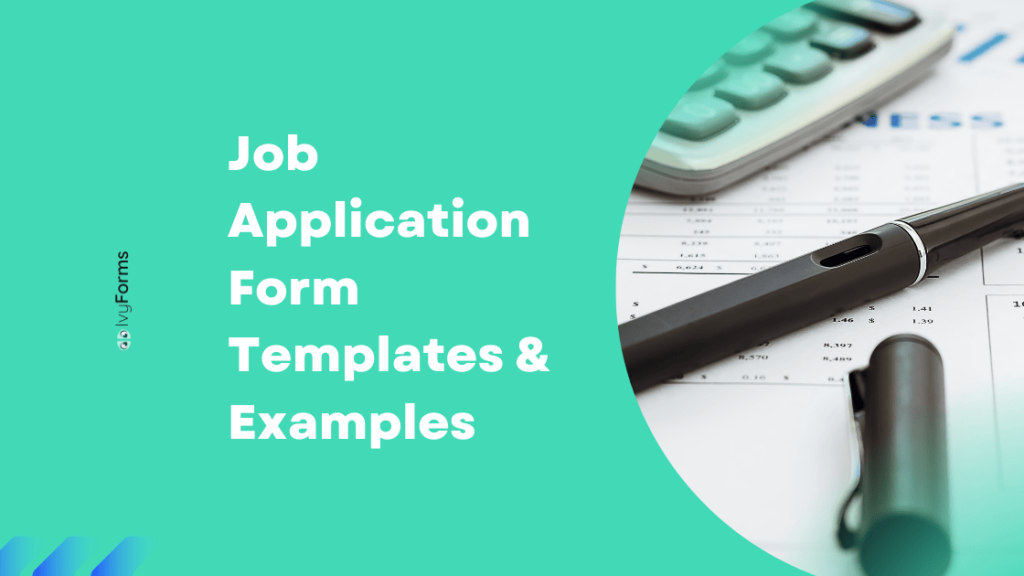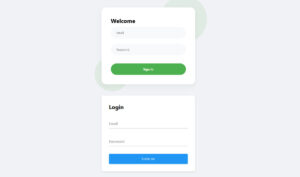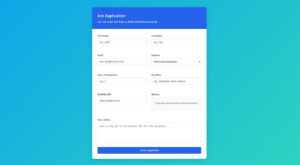Tailwind CSS has revolutionized how we create and style forms. Its utility-first approach offers a seamless way to build and customize form elements, making the task of front-end development more…
Table of Contents
A well-crafted job application form can significantly improve your hiring process. It’s a great fit for both HR managers in large corporations and a small business owner because using a structured job application form template to gather candidate information helps you efficiently identify the right person for the role.
In this post, we’ll explore job application form templates and examples that simplify the creation of effective forms. We’ll cover everything from the essential components and different types of templates to real-life samples and templates that will inspire you. By the end, you’ll have practical tips and resources to refine your application process and hire the best candidates faster.
What Is a Job Application Form?
A job application form is a standardized document that collects essential information from candidates during the hiring process. It serves as a tool for employers to gather details such as personal information, work experience, education, skills, and references in a structured manner. Unlike resumes, which vary widely in format and content, job application forms ensure consistency, making it easier for employers to compare candidates.
Employers use these forms for various reasons, including:
- Ensuring uniformity: Each applicant provides the same information, which simplifies the comparison process.
- Screening efficiency: Forms focus on the specific data employers need, helping to filter out unqualified candidates early on.
- Legal documentation: Properly designed forms can help ensure compliance with employment laws, as they avoid collecting unnecessary or discriminatory information.
Benefits of Using a Job Application Form Templates
If you’re tired of sifting through inconsistent resumes, job application form templates will change your life. They bring order to the chaos by making sure every applicant gives you the same critical details. Plus, you’ll save time and make sure you’re staying compliant with legal standards, all while looking more professional to potential hires.
Let’s break down why templates are such a smart move.
- Consistency: Templates ensure every applicant provides the same set of information, which makes reviewing applications more efficient.
- Saves time: Pre-made job application form templates eliminate the need to create forms from scratch for each job opening. You can quickly customize them as needed.
- Compliance with legal standards: Templates can help ensure you collect only relevant and non-discriminatory information, reducing the risk of legal issues.
- Professional appearance: A well-structured form enhances your company’s professional image, providing a seamless experience for applicants.
- Better decision-making: With all the important data readily available in a structured format, comparing and evaluating candidates becomes easier.
| Benefit | What you get |
| Consistency | Ensures all applicants provide the same information |
| Saves time | Ready-to-use templates reduce manual effort |
| Compliance with legal standards | Helps avoid collecting unnecessary or inappropriate data |
| Professional appearance | Creates a polished and organized application process |
| Better decision-making | Simplifies candidate comparison by organizing data clearly |
Key Components of The Best Job Application Form Templates
The best job application form templates are comprehensive yet easy for applicants to fill out. By including these components, you’ll get a complete snapshot of the candidate’s experience and qualifications, making it easier to compare and evaluate applicants.
- Personal information: Full name, contact details, and address are the basics you’ll want to collect upfront.
- Employment history: A section to list previous job positions, company names, employment dates, and job responsibilities.
- Education background: Schools attended, degrees earned, and any relevant certifications.
- Skills and qualifications: Give applicants space to showcase specific skills that align with the job description.
- References: Contact information for professional references who can vouch for the candidate’s qualifications.
- Availability: Knowing when a candidate can start and their preferred work schedule helps speed up the hiring process.
- Signature and date: Including a signature ensures the information provided is accurate and legally binding.
Common Types of Job Application Forms Templates
When it comes to job application forms, there are several types of forms you might encounter or want to use, each with its own unique advantages. Understanding these can help you choose the right format for your hiring needs:
- Standard application forms: These are the most common type, featuring all the essential components we’ve discussed. They’re straightforward and effective for most roles.
- Online application forms: With the shift towards digital hiring, many companies use online forms that candidates can fill out through their website. These forms often come with additional features, like automatic validation checks and easier data management.
- Customizable templates: For businesses with specific needs, customizable templates allow you to add or remove sections according to your hiring criteria. This flexibility ensures you get the information that matters most.
- Industry-specific forms: Some industries may require specialized information (e.g., healthcare or education). Using templates tailored to these fields can help ensure you capture all necessary details.
- Mobile-friendly forms: As more applicants use smartphones to apply for jobs, mobile-friendly forms are becoming essential. These templates are designed to be easily navigated on smaller screens, increasing the chances of application completion.
- Printable application forms: For businesses that prefer paper applications, printable forms are handy. They allow applicants to fill out information by hand, which can be useful in certain environments, like job fairs or community events.
| Type | Description |
| Standard application forms | Commonly used forms that include all essential components |
| Online application forms | Digital forms that streamline data collection and management |
| Customizable templates | Flexible forms that can be tailored to specific hiring needs |
| Industry-specific forms | Templates designed for specific sectors, capturing relevant information |
| Mobile-friendly forms | Optimized forms for smartphone users, improving application completion rates |
| Printable application forms | Forms that can be filled out by hand, useful for in-person applications |
Job Application Form Example
To illustrate how job application forms can look in practice, we’ve prepared detailed examples from various industries. These examples provide a clear picture of how different companies tailor their job application forms to their specific needs, ensuring they collect relevant information while getting to know potential candidates better.
| Company | Form Structure |
| Retail | Personal Information:
– Full Name – Address – Phone Number Employment History: – Previous Employer – Job Title – Dates of Employment – Responsibilities Availability: – Days Available (check boxes for Mon-Sun) – Preferred Shift (Morning/Afternoon/Evening) Additional Questions: – “What is your favorite fashion brand?” – “Describe a time you provided excellent customer service.” |
| Tech | Personal Information:
– Full Name – Contact Information Technical Skills: – Proficient Programming Languages (check boxes: Python, Java, JavaScript, etc.) – Years of Experience – Link to Portfolio/GitHub Work History: – Company Name – Job Title – Key Projects/Responsibilities Coding Challenge: – “Solve the following problem: Write a function to reverse a string.” |
| Healthcare | Personal Information:
– Full Name – Contact Information – Address Education: – Degree Earned – Institution Name – Graduation Date Certifications: – CPR Certification (Yes/No) – ACLS Certification (Yes/No) Scenario Question: – “How would you handle a patient experiencing a panic attack?” |
| Non-Profit | Personal Information:
– Full Name – Phone Number Volunteer Experience: – Previous Organizations – Role/Responsibilities Motivation: – “Why do you want to volunteer with Community Helpers?” – “Share a cause that you are passionate about.” Availability: – “When are you available to volunteer?” (Free text box) |
| Hospitality | Personal Information:
– Full Name – Address – Phone Number Work Experience: – Previous Employer – Job Title – Dates of Employment – Responsibilities Skills: – “List any relevant hospitality skills (e.g., customer service, food safety certification).” Work Environment Preferences: – “What type of work environment do you prefer?” (Options: Fast-paced, Team-oriented, etc.) |
Free Job Application Form Template
Ready to create your own job application form? We’ve made it easy for you with a free template. This template is designed to be straightforward and customizable, ensuring you can adapt it to fit your specific hiring needs.
Feel free to modify this template by adding or removing sections as necessary, and adjust it to match your company’s branding. Whether you’re looking for a straightforward form or something more tailored, this template can be a great starting point.
Tips for using your template:
- Customize the sections according to the position you’re hiring for.
- Keep the form clear and concise to encourage applicants to complete it.
- Make sure to test the form for any usability issues before rolling it out.
| Section | Details to be Filled | ||||||||||||
| Personal Information | – Full Name (First, Middle, Last): [Your Answer]
– Address (Street, City, State, ZIP Code): [Your Answer] – Phone Number: [Your Answer] – Email Address: [Your Answer] – Social Security Number (Optional): [Your Answer] – Date of Birth: [MM/DD/YYYY] – Legally eligible to work in the U.S.? ☐ Yes ☐ No – Ever convicted of a felony? ☐ Yes ☐ No If yes, explanation: [Your Answer] |
||||||||||||
| Position Details | – Position Applied For: [Your Answer]
– Desired Salary/Hourly Rate: [Your Answer] – How did you hear about this position? ☐ Online Job Board ☐ Company Website ☐ Referral ☐ Other (If referral, name): [Your Answer] – Available Start Date: [MM/DD/YYYY] – Willing to relocate? ☐ Yes ☐ No – Type of Employment: ☐ Full-time ☐ Part-time ☐ Temporary ☐ Intern – Availability (Days/Hours): [Your Answer] |
||||||||||||
| EDUCATION HISTORY |
|
||||||||||||
| EMPLOYMENT HISTORY |
|
||||||||||||
| PROFESSIONAL REFERENCES |
|
||||||||||||
| Skills & Qualifications | – Skills: [Your Answer]
– Certifications: [Your Answer] – Languages: [Your Answer] – Software Proficiency: [Your Answer] – Other Relevant Qualifications: [Your Answer] |
||||||||||||
| Additional Questions | – Why do you want to work for our company? [Your Answer]
– What motivates you in a work environment? [Your Answer] – Describe a time when you overcame a challenge at work. [Your Answer] – Where do you see yourself in 5 years? [Your Answer] |
||||||||||||
| Agreement | I certify that all information provided in this application is true and complete to the best of my knowledge.
I understand that providing false information may disqualify me from further consideration for employment and may result in termination if discovered at a later date. I authorize the company to contact my references and verify my employment history. Signature: [Your Signature] Date: [MM/DD/YYYY] |
How to Customize a Job Application Form Templates & Examples
Customizing your job application form is essential for gathering the information that matters most to your hiring process. By tailoring the template to reflect your company’s unique needs and the specific roles you’re hiring for, you can create a more efficient and effective application experience. Here are some practical steps to help you make those adjustments:
Identify your needs
Start by assessing the specific roles you are hiring for. Think about the essential information you want from candidates based on the job responsibilities and qualifications. For example, if you’re filling a technical position, prioritize technical skills and relevant experience.
Choose the right format
Decide whether you want a paper form, an online form, or a hybrid approach. Online forms can offer more flexibility and convenience, making data collection and analysis easier.
Modify sections
Adjust the sections of your template based on the role. If certain sections aren’t relevant, feel free to remove them. On the flip side, if you need specific information, such as portfolio links for creative roles, add those fields.
Use clear language
Make sure the language in your form is straightforward and easy to understand. Avoid jargon or overly technical terms that could confuse applicants. Providing clear instructions can help improve completion rates.
Include company branding
Make the form visually appealing by incorporating your company’s branding elements, like your logo, colors, and fonts. A branded application form reflects professionalism and creates a positive first impression.
Add instructions or guidelines
Include any necessary instructions for filling out the form, such as the preferred file format for attachments or the maximum word count for open-ended questions. This guidance helps streamline the application process.
Test the form
Before launching your application form, conduct a test run with a few team members. This practice helps identify any potential issues, like confusing questions or technical glitches, leading to a smoother experience for candidates.
Review and update regularly
Job markets and company needs change over time. Regularly review your application form to keep it relevant and effective. Gather feedback from hiring managers and candidates to continuously improve the form.
Conclusion
Remember that the application form is often the first interaction potential employees have with your company. Make it count by ensuring it reflects your company culture and values. With the right approach, your job application form can become a powerful tool in your recruitment strategy.
By using templates, customizing them to fit your organization’s needs, and incorporating clear instructions, you can attract the right candidates and enhance their experience.
FAQs About Job Application Form Templates
What is a job application form template?
A job application form template is a pre-designed document that outlines the information needed from job candidates. It helps streamline the application process and ensures consistency across applications.
Why should I use a job application form?
Using a job application form helps you gather important information in a structured way, making it easier to compare candidates and assess their qualifications.
Can I customize a job application form template?
Absolutely! Templates are designed to be customized based on your specific hiring needs and company culture.
What should I include in a job application form?
Essential components typically include personal information, employment history, education, skills, and any specific questions relevant to the position.
Where can I find job application form templates?
You can find job application form templates online, often for free, or create your own using document editing software.






